China Enacts Additional 34% Tariffs on All U.S. Imports Effective April 10

Synopsis
Key Takeaways
- China will impose a 34% tariff on U.S. imports.
- New tariffs are effective from April 10.
- 11 American companies are now deemed "unreliable entities".
- India may gain from these tariffs as China faces higher duties.
- Collaboration with FTA partners is crucial for India.
Beijing, April 4 (NationPress) In a significant escalation of the trade conflict, China will implement an additional 34 percent tariffs on all imports from the United States starting April 10, as declared by the Customs Tariff Commission of the State Council on Friday.
This declaration follows the U.S. decision to enforce "reciprocal tariffs" on Chinese goods, which the commission criticized for violating international trade norms, severely compromising China's legitimate rights, and exemplifying unilateral coercion, according to reports from Xinhua news agency.
The Ministry of Commerce in China announced that it would be adding 11 American firms to its list of "unreliable entities," effectively prohibiting them from conducting business within China or with Chinese enterprises.
Moreover, the ministry has enforced strict restrictions on the export of certain rare earth materials, such as gadolinium and yttrium, which are predominantly sourced from China and are critical for products ranging from electric vehicles to precision weaponry.
The U.S. President, Donald Trump, has announced reciprocal tariffs of 54 percent on China, including previously established duties. This positions China as one of the nations most adversely affected by these tariffs.
Global investment institution JP Morgan now estimates a 60 percent likelihood of the global economy entering a recession by the end of 2025, an increase from the previous 40 percent.
Analysts suggest that the reciprocal tariffs imposed by the U.S. will undoubtedly impact all nations, yet Indian exporters might gain a competitive edge as China faces heightened duties, potentially exceeding 65 percent.
The additional 27 percent tariff on India places it within the lower echelons of affected countries, opening up new opportunities beyond the standard export markets such as engineering goods, electronics, gems, jewelry, textiles, and apparel.
These tariffs could also enhance India's competitive standing in sectors where regional competitors are hit harder.
To fully leverage this advantage, India must engage with the U.S. to preserve market access and collaborate with FTA partners in Asia to reorganize supply chains and capitalize on emerging opportunities, according to expert insights.







